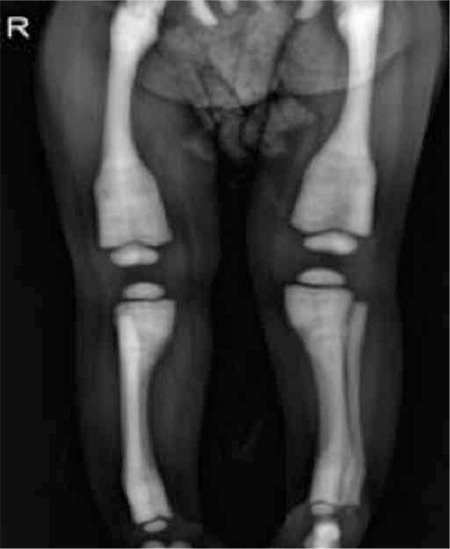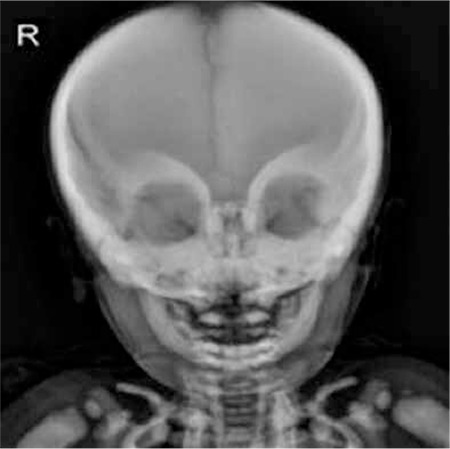QUIZ IN HEMATOLOGY
A 2-year-old patient was admitted to the hospital on the fifth day of his life with hypocalcemic seizure. When he was 3 months of age, blindness and hepatosplenomegaly were noticed. His leukocyte count was 36.8x10³/µL, hemoglobin level was 8 g/dL, and platelet level was 103x10³/µL; he was referred with suspicion of infantile leukemia. His peripheral smear demonstrated several immature myeloid cells and normoblasts, while no blastic cells were observed. Chest radiograph showed a generalized increase in bone density (Figure 1). Radiographs of the skull and limbs showed generalized increase in bone density (Figures 2 and 3).
Figure 1. Posteroanterior chest X-ray revealed a uniform increase in bone density.

Figure 2. Radiograph of limbs shows Erlenmeyer flask deformity of distal femur and generalized increased bone density with the obliteration of the marrow cavity.

Figure 3. Radiograph of skull showing sclerosis and thickening of orbital rims.

DIAGNOSIS
The patient was diagnosed with osteopetrosis, which was confirmed due to mutation in the TCIRG1 gene [g.11279G>A(IVS18+1) paternal allele, g.8280_9560del (ex. 11-12-12), p.Ala389AspfsX151 maternal allele].
Osteopetrosis originates from reduced or complete lack of osteoclast function and, as a consequence, impairment of bone resorption [1]. At least 10 genes have been identified as causative in humans [2]. Osteopetrosis varies in its presentation and severity. The autosomal recessive form is the most severe form, with life-threatening complications such as bone marrow failure; it is usually diagnosed before 1 year of age and can mimic leukemia [1,3]. The bone seems to be the only affected tissue and the defect can be almost completely reversed by hematopoietic stem cell transplantation [1,3].
References
- 1.Balemans W, Van Wesenbeeck L, Van Hul W. A clinical and molecular overview of the human osteopetroses. Calcif Tissue Int. 2005;77:263–274. doi: 10.1007/s00223-005-0027-6. [DOI] [PubMed] [Google Scholar]
- 2.Stark Z, Savarirayan R. Osteopetrosis. Orphanet J Rare Dis. 2009;4:5–5. doi: 10.1186/1750-1172-4-5. [DOI] [PMC free article] [PubMed] [Google Scholar]
- 3.Gerritsen EJ, Vossen JM, Loo IH, van, Hermans J, Helfrich MH, Griscelli C, Fischer A. Autosomal recessive osteopetrosis: variability of findings at diagnosis and during the natural course. Pediatrics. 1994;93:247–253. [PubMed] [Google Scholar]


